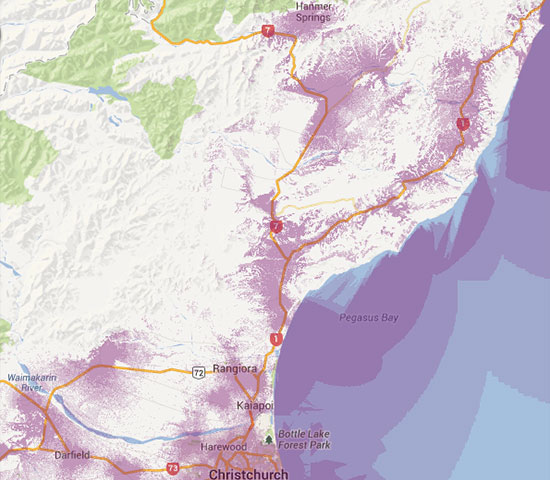
As part of the reinvention of their brand, Vodafone recently launched their new “Red” plans which, accompanied by Red Roaming, allow you to roam internationally to over 40 countries using your phone with you number, your SIM and your plan entitlements. The price for this convenience is an extra $5 a day charge while overseas – an effort to curb bill shock for short term overseas travellers.
There’s usually a difference between marketing hype and real world experience, so on a recent 2-week trip to New Zealand in October, I took the opportunity to review the service for myself. I spent most of my time in Christchurch, and some of the surrounding areas.
The Red Option
To use Red Roaming, you need to be using one of Vodafone’s new Red plans, launched in late August. It’s generally accepted that these plans offer good value to customers, and if you’re due to re-contract your service it’s probably worth looking at it as you’ll also be able to get on Vodafone’s new 4G network.
The price for using Red Roaming is simple – you’ll incur a $5 charge when you make or receive a call or use data on your service. This can add up the longer you stay overseas – you’ll add $35 per week to your phone bill if you use your phone every day. My 15 day stay in New Zealand cost $75, an entire month – and then some – on top of my existing bill.
The Local Option
Many travellers choose to purchase a pre-paid SIM at their destination and use it while overseas. This isn’t a bad option – I’ve done it myself, and a trip to the UK (at the time) ended up costing around $50 for 6 weeks. Red Roaming for that same trip would cost $210.
If you roam with a local prepaid SIM, you need to consider not just your bill, but others. While your usage of the local network at your destination will be cheap, if your family and friends need to call you while overseas, it’ll cost them an international call. If you need to call them, it’ll cost you international call. Prepaid plans tend not to offer particularly cheap international calling rates, and you may also end up shelling out for an international calling card in order to phone home.
Also consider the fact that you need to get your new number to family and friends that may need to contact you. If you’re visiting multiple countries, you’ll need multiple SIM cards and you’ll usually be dealing with a new number in each country (though, to be fair, some carriers do offer roaming to multiple countries in Europe). Additionally, you’ll likely be dealing with an unknown carrier, so recharges and support channels (especially in non-English-speaking countries) may not be as straightforward as that which you’re used to back home.
Cost vs Convenience
I wound up balancing Red Roaming’s per-day cost with convenience. Red Roaming plans let you stay in touch in a convenient and cost-effective way.
For me, the convenience won out over the cost. When I was travelling, my wife and kids were still in Australia so on a normal global roaming some individual calls to and from home would have cost somewhere in the vicinity of $10-$15 each. If I’d been using a prepaid SIM connected to a New Zealand carrier, I’d have faced international calling charges per-call to call home, and my family would also have to make an international call to reach me.
I speak to my family several times a day. That $5 daily charge suddenly looks pretty attractive.
The convenience was fantastic – before I had even cleared customs on arrival to New Zealand, my phone was already connected and working with my number, my contacts, using my call and data allowance – all I had to do was connect to the Vodafone NZ network. Exactly as advertised by Vodafone.
Coverage Concerns
It’s important to check the local carrier’s coverage maps at your destination – specifically, the areas that you’re heading to – to be sure that you’ll be able to use the service properly if you spend time away from major metropolitan centres. Your $5 / day may not get you very far in remote areas.
Heading North out of Christchurch to Hanmer Springs, I found there were a few stretches where I had no coverage — emergency calls only. You can see the patches on Vodafone NZ’s coverage map below:

You should consider that Vodafone perhaps wouldn’t be your carrier of choice depending on your precise destination.
The Wrap Up
Red Roaming changes the global roaming price structure in a way that’s welcome to many travellers, and it shows that Vodafone is serious about offering customers services that their competitors do not. The convenience and value is clear – while a long stay overseas can certainly get pricey very quickly, for many the convenience will likely outweigh the cost.
I’ll certainly use Red Roaming again when I next travel overseas, and I’ll be recommending the service to family and friends who are using Vodafone.
You can find more information about Red Roaming at Vodafone.
Next time you travel overseas, is Red Roaming an option you’ll consider, will you purchase a local prepaid SIM or “go dark”?




The map above is 2G only.
Tick 3G Extended to get 900Mhz 3G coverage and some of those gaps fill up with coverage.
Actually the map screenshot was taken with all options – “Calling, 2G & 2.5G”, “3G Broadband” and “3G Broadband Extended” – selected on http://www.vodafone.co.nz/network/coverage/ (click “Check your coverage” under “Check 2G/3G coverage”.